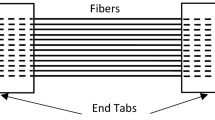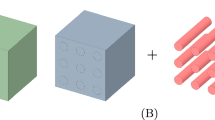Abstract
The primary aim of this investigation was to establish the strength characteristics of S-glass fiber bundles and composites subjected to quasi-static loading. Ten glass-bundle specimens and glass-fiber unilayer specimens, each containing thirty-one approximately equally spaced fibers (S-glass, 0.00485-in. diameter) were prepared and tested in an Instron machine at three strain rates (0.0265 in./in./min, 0.66 in./in./min and 26.5 in./in./ min). Grid lines were placed on composite specimen producing interference moiré fringes with a reference master grid placed in front of the specimen. The specimens were observed photographically during deformation. The experimental bundle strength compares well with that obtained on the basis of Daniels' theory. The experimental standard deviation is, however, much larger than that predicted theoretically. The experimental mean composite strength is compatible with that obtained on the basis of rule of mixtures and Gücer-Gurland models. The Zweben crack-propagation criterion [E 2(f C )=1] gives too low a value for the composite strength. A new criterion [E 3(fC)=1] is suggested for the present test series. Due to the rather large standard deviation and the small number of test samples it was not possible to quantitatively evaluate the effect of rate of straining. However, it is observed that, within the range of strain rates employed, the effect of strain rate on bundle and composite strengths does not exceed 20 percent and 10 percent, respectively.
Similar content being viewed by others
Abbreviations
- d f :
-
fiber diameter
- E i :
-
groups containingi fiber breaks (i=1, 2, 3…)
- E f :
-
Young's modulus for the fibers
- E m :
-
Young's modulus for the matrix
- E L (f):
-
expected strength of fibers of lengthL
- f :
-
stress
- f B :
-
bundle strength (load/fiber cross-section area)
- f c :
-
composite strength (load/fiber cross-section area)
- G m :
-
shear modulus of the matrix
- L :
-
specimen length
- n :
-
number of slabs (L/δ)
- N :
-
number of fibers
- v :
-
Instron head speed
- V f :
-
fiber volume fraction
- V m :
-
matrix volume fraction
- α,β:
-
Weibull distribution parameters
- δ:
-
ineffective length (length that carries less than 90 percent of the fiber load)
- \(\dot \varepsilon\) :
-
strain rate
- ψ:
-
bundle standard deviation
- \(\psi _C\) :
-
composite standard deviation
References
Dow, N. F., Rosen, B. W. andHashin, Zvi, “Studies of Mechanics of Filamentary Composites,”Space Sciences Laboratory, Missile and Space Division, General Electric Company, Philadelphia, Pa. (Dec. 1965).
Materials Advisory Board Ad Hoc Committee on Micromechanics of Fibrous Composites, “Micromechanics of Fibrous Composites,”National Academy of Sciences-National Research Council, Washington, D. C. (May 1965).
Kelly, A. and Davies, G. J., “The Principles of Fiber Reinforcement of Metals,” Metallurgical Reviews,10, (37), (1965).
Tyson, W. R. andDavies, G. J., “A Photoelastic Study of the Shear Stresses Associated with the Transfer of Stress During Fiber Reinforcement,”Brit. Jnl. Appl. Phys.,16,199–205 (1965).
Schuster, D. M. andScala, E., “The Mechanical Interaction of Sapphire Whiskers with a Birefringent Matrix,”Trans. AIME,230,1635–1640 (1964).
MacLaughlin, T. F., “Effect of Fiber Geometry on Stress in Fiber-reinforced Composite Materials,”Experimental Mechanics,6,481–492 (1966).
MacLaughlin, T. F., “A Photoelastic Analysis of Fiber Discontinuities in Composite Materials,”Jnl. of Composite Materials,2,44–55 (1968).
Edelman, W. E. and Dahlke, H. J., “Photomechanics of Stresstransfer Mechanism in Composite Materials,” 1967 SESA Annual Meeting, Chicago, Ill., Oct. 31–Nov. 3.
Jenkins, D. R., “Analysis of Behavior Near a Cylindrical Glass Inclusion by Scattered Light Photoelasticity,” Owens-Corning Fiberglass Co.
Ebullin, J., Berry, J. W. and Gatti, A., “Some Fundamental Fracture Mechanisms Applicable to Advanced Filament Reinforced Composites,” Space Sciences Laboratory, Materials Section, General Electric Co., Missile Space Div.
Pih, D. and Sutliff, D. R., “Photoelastic Analyses of Reinforced Composites,” AFML-TR-68-380 (Nov. 1968).
Rosen, B. W., “Mechanics of Composite Strengthening, Fiber Composite Materials,” Am. Soc. Metals (1965).
Zweben, C., “Tensile Failure Analysis of Fibrous Composites,”AIAA Jnl.,6 (12),2325–2331 (1968).
Boue, C. A., “Microscopic Study of Mode of Fracture in Filament Wound Glass Resin Composites,”T. & A. M. Report No. 234, Univ. of Ill. (Urbana), (Nov. 1962).
Grinius, V. G., “Micromechanics-Failure Mechanism Studies,” Technical Report AFML-TR-66-177, Air Force Materials Laboratory (Aug. 1968).
Friedman, E., Flom, D. G. and Mazzio, V. F., “High Strength, High Modulus Whisker Reinforced Plastic Composites,” Technical Report AFML-TR-66-362, Air Force Materials Laboratory (Feb. 1967).
Jech, R. W., McDaniels, D. L. and Weston, J. W., “Fiber Reinforced Metallic Composites,” Proc. Sixth Sagamore Ordnance Materials Research Conf. (Aug. 1959).
Parratt, N. J., “Defects in Glass Fibers and Their Effect on the Strength of Plastic Mouldings,” Rubber Plastics,41, (263) (1960).
Coleman, B. D., “A Stochastic Process Model for Mechanical Breakdown,”Trans. Soc. of Rheology,1,153–168 (1957).
Gücer, D., Gurland, J., “Comparison of the Statistics of Two Fracture Modes,”Jnl. Mech. Phys. Solids,10,365–373 (1962).
Zweben, C. and Rosen, B. W., “A Statistical Theory of Material Strength with Application to Composite Materials,” AIAA Paper No. 69-123, Presented at AIAA 7th Aerospace Sciences Meeting, New York, Jan. 20–22, 1969.
McKee, R. B. Jr., and Sines, G., “A Statistical Model for the Tensile Fracture of Parallel Fiber Composites,” ASME Paper No. 68-WAIRP-7, Presented at ASME Winter Annual Meeting, New York, Dec. 1–5, 1968.
Daniels, H., “The Statistical Theory of the Strength of Bundles of Threads 1,”Proc. Royal Society,183A,405–435 (1945).
Armenàkas, A. E., Garg, S. K. andSciammarella, C. A., “Strength Characteristics of Glass Fibers Under Dynamic Loading,”Jnl. of Appl. Phys.,41 (4),1657–1664 (March 1970).
Coleman, B. D., “On the Strength of Classical Fibers and Fiber Bundles,”Jnl. Mech. Phys. Solids,7,60–70 (1958).
Epstein, B., “Statistical Aspects of Fracture Problems,”Jnl. Appl. Phys.,19,140–147 (1948).
Hedgepeth, J., “Stress Concentrations in Filamentary Structures,” NASA TN D-882 (May 1961).
Additional information
A. E. Armenakas, S. K. Garg, C. A. Sciammarella and V. Svalbonas were associated with Polytechnic Institute of Brooklyn at the time that paper was prepared.
Rights and permissions
About this article
Cite this article
Armenakas, A.E., Garg, S.K., Sciammarella, C.A. et al. Experimental study of the failure mechanism and strength characteristics of fiber bundles and composites. Experimental Mechanics 12, 1–10 (1972). https://doi.org/10.1007/BF02320783
Issue Date:
DOI: https://doi.org/10.1007/BF02320783




